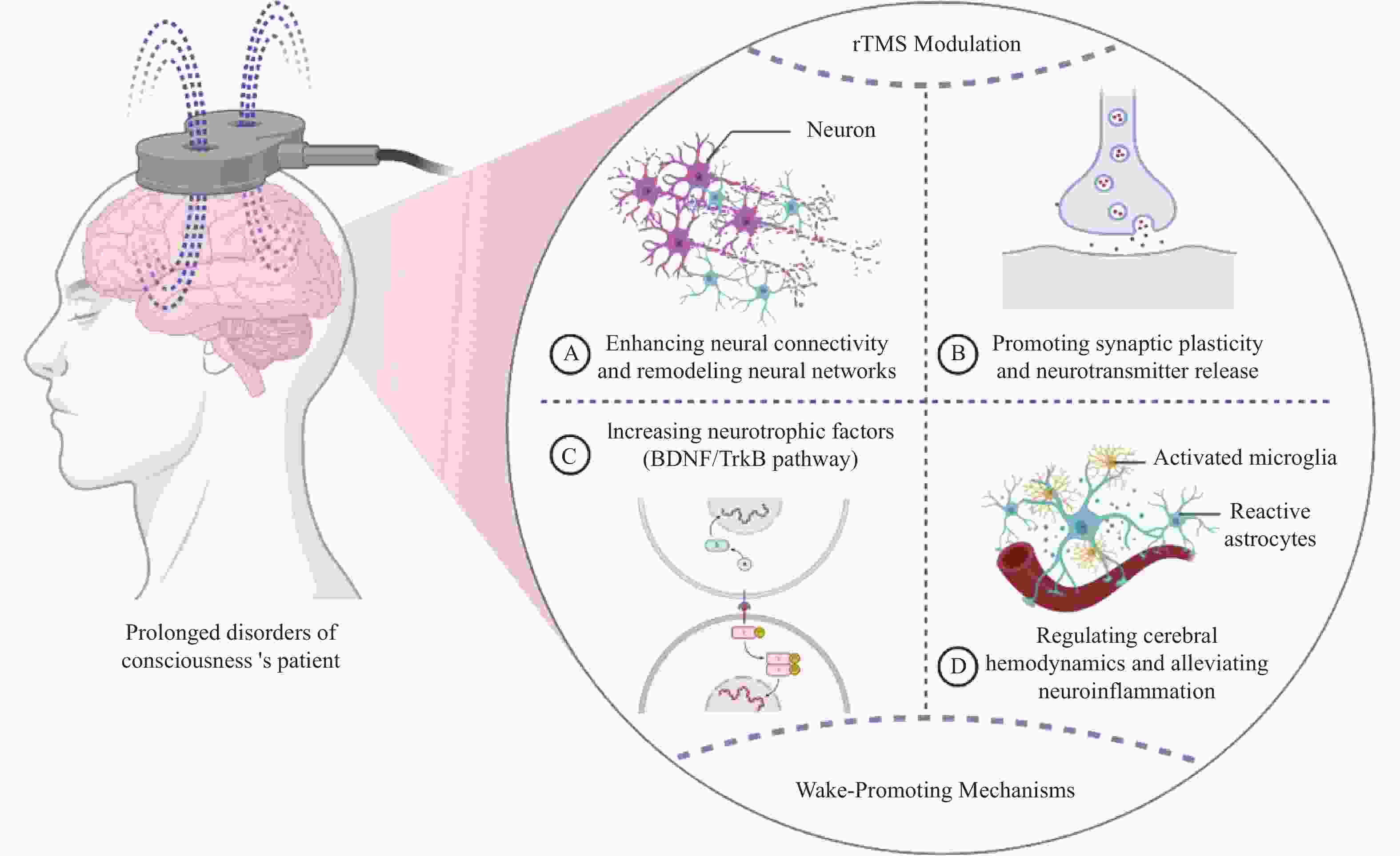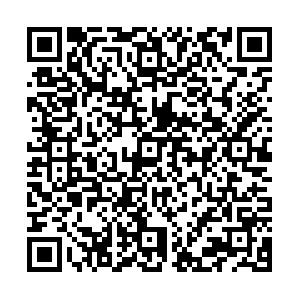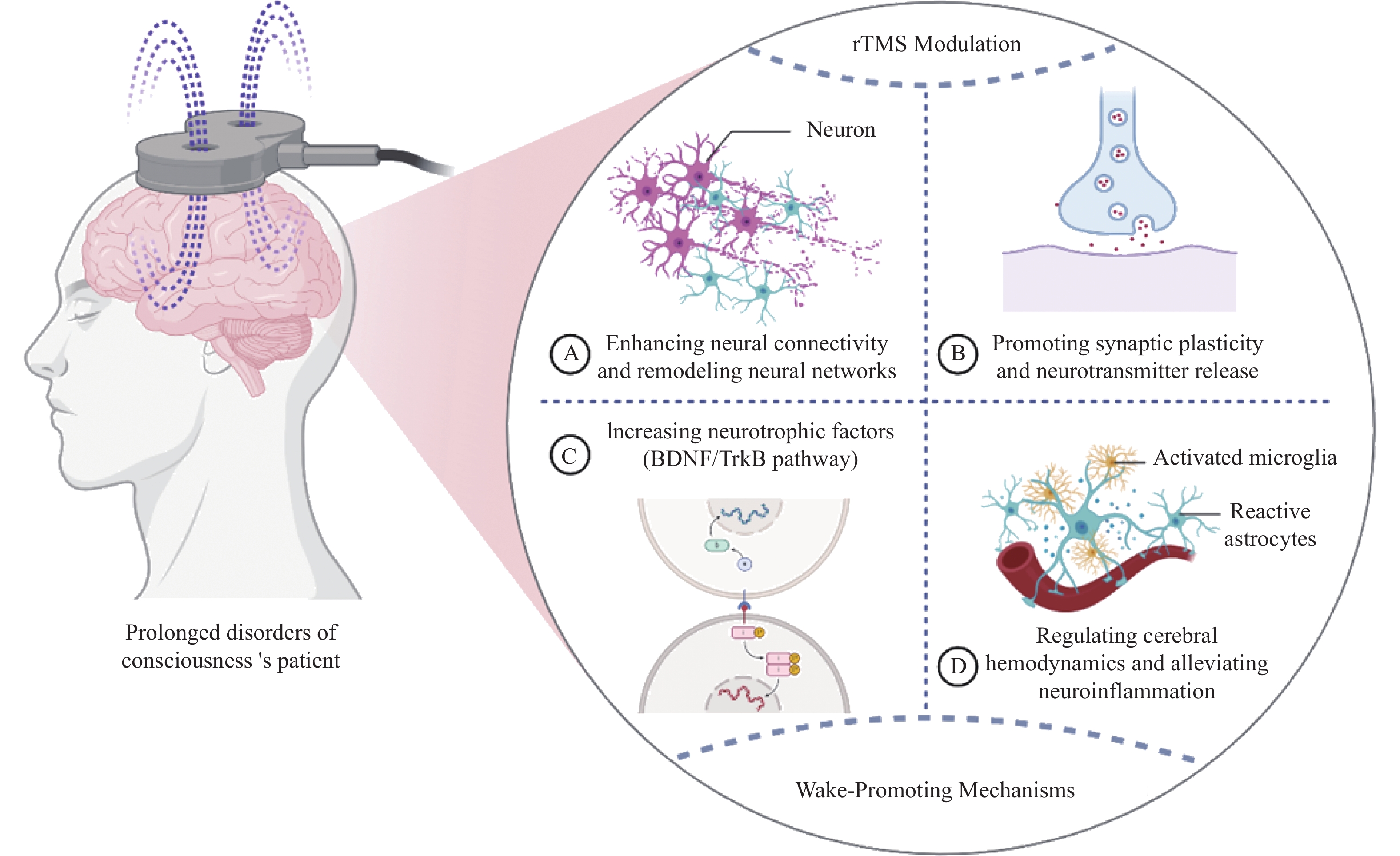Clinical Applications and Potential Mechanisms of Repetitive Transcranial Magnetic Stimulation in Prolonged Disorders of Consciousness
-
摘要: 慢性意识障碍(pDoC)病情复杂且病程长,严重影响患者的预后,是目前临床治疗的难点。近年来,基于神经调控机制的促醒疗法在pDoC患者的评估及诊疗中运用广泛。重复经颅磁刺激(rTMS)技术通过调节患者的神经活动,进而改善意识状态,对pDoC患者具有积极的促醒疗效。但rTMS的最佳刺激参数和促醒机制尚未明确。对pDoC的病理机制、rTMS不同靶点和刺激频率的临床应用进行系统综述,重点探讨rTMS通过改变神经通路和重塑脑网络、促进突触可塑性和神经递质释放、调节神经营养因子表达及调控脑血流动力学等神经机制促进意识恢复的作用,并基于人工智能展望rTMS在未来临床研究中的应用前景。Abstract: Prolonged disorders of consciousness (pDoC) are complex and prolonged conditions that severely impact patient prognosis and remain a clinical treatment challenge. In recent years, neural regulation-based awakening therapies have been widely applied in the assessment and treatment of pDoC patients. Repetitive transcranial magnetic stimulation (rTMS) technology can regulate neural activity and improve patients' consciousness states, demonstrating positive awakening effects for pDoC patients. However, the optimal stimulation parameters and awakening mechanisms of rTMS remain unclear. This article reviews the pathological mechanisms of pDoC, clinical applications of rTMS at different targeting sites and stimulation frequencies, and focuses on exploring how rTMS promotes consciousness recovery through neural mechanisms such as altering neural pathways, reshaping brain networks, promoting synaptic plasticity and neurotransmitter release, regulating neurotrophic factor expression, and modulating cerebral hemodynamics. Based on artificial intelligence, the article also prospects the future clinical research applications of rTMS.
-
表 1 不同靶点与频率rTMS治疗慢性意识障碍的临床研究
Table 1. Clinical studies of rTMS with different targets and frequencies in pDoC
被试者 刺激靶点 刺激频率 调控参数 治疗周期 主要结果 参考文献 99例VS 患侧M1 20 Hz 90% RMT,8000脉冲 4周 临床和神经生理反应明显改善 [22] 6例pDoC 左侧M1 20 Hz 100% RMT,1000脉冲 5 d 仅1例患者有行为改善和EEG变化 [23] 7例pDoC
11例健康人左侧M1 20 Hz 100% RMT,1000脉冲 5 d 1例MCS患者的CRS-R评分升高,
功能连接明显增强[24] 11例VS 左侧M1 20 Hz 90% RMT,1000脉冲 4周 行为和脑电均无明显改善 [39] 20例pDoC 右侧DLPFC 5 Hz - 4周 6例患者意识和行为改善 [37] 10例健康人
10例UWS右侧DLPFC 10 Hz 90% RMT,1000脉冲 1次 3例UWS患者出现短暂临床改善 [25] 32例VS 右侧DLPFC 10 Hz 100% RMT,1575脉冲 20 d 增加CRS-R评分,降低MEP和CMCT [26] 50例pDoC 左侧DLPFC 10 Hz 90% RMT,1000脉冲 6周 神经行为和电生理指标明显改善 [27] 8例MCS / UWS 左侧DLPFC iTBS 80% RMT,600脉冲 5 d CRS-R评分和脑电改善明显 [41] 11例pDoC 楔前叶 10 Hz 90% RMT,1200脉冲 2周 神经行为和静息态脑电改善 [32] 16例VS
22例MCS左侧角回 20 Hz 80% RMT,3200脉冲 2周 MCS患者的CRS-R总分改善 [35] 26例pDoC 顶叶 10 Hz 90% RMT,1000脉冲 2周 行为和脑电改善明显 [36] -
[1] 张皓, 凌锋. 慢性意识障碍康复中国专家共识[J]. 中国康复理论与实践, 2023, 29(2): 125-139. doi: 10.3969/j.issn.1006⁃9771.2023.02.001 [2] Giacino J T, Katz D I, Schiff N D, et al. Practice guideline update recommendations summary: Disorders of consciousness: Report of the guideline development, dissemination, and implementation subcommittee of the American academy of neurology; the American congress of rehabilitation medicine; and the national institute on disability, independent living, and rehabilitation research[J]. Neurology, 2018, 91(10): 450-460. [3] Strauss D J, Ashwal S, Day S M, et al. Life expectancy of children in vegetative and minimally conscious states[J]. Pediatr Neurol, 2000, 23(4): 312-319. doi: 10.1016/S0887-8994(00)00194-6 [4] Knapik P, Borowik D, Cieśla D, et al. Epidemiology and clinical characteristics of patients discharged from the ICU in a vegetative or minimally conscious state[J]. PLoS One, 2021, 16(6): e0253225. doi: 10.1371/journal.pone.0253225 [5] 汤时蓝, 谢可欣, 刘玲谕, 等. 慢性意识障碍患者康复预后及照护研究进展[J]. 中国全科医学, 2023, 26(27): 3342-3348+3354. [6] Vitello M M, Rosenfelder M J, Cardone P, et al. A protocol for a multicenter randomized and personalized controlled trial using rTMS in patients with disorders of consciousness[J]. Front Neurol, 2023, 14: 1216468. doi: 10.3389/fneur.2023.1216468 [7] Lefaucheur J P, Aleman A, Baeken C, et al. Evidence-based guidelines on the therapeutic use of repetitive transcranial magnetic stimulation (rTMS): An update (2014-2018)[J]. Clin Neurophysiol, 2020, 131(2): 474-528. doi: 10.1016/j.clinph.2019.11.002 [8] Zhou L, Jin Y, Wu D, et al. Current evidence, clinical applications, and future directions of transcranial magnetic stimulation as a treatment for ischemic stroke[J]. Front Neurosci, 2023, 17: 1177283. doi: 10.3389/fnins.2023.1177283 [9] Vucic S, Stanley Chen K H, Kiernan M C, et al. Clinical diagnostic utility of transcranial magnetic stimulation in neurological disorders. Updated report of an IFCN committee[J]. Clin Neurophysiol, 2023, 150: 131-175. doi: 10.1016/j.clinph.2023.03.010 [10] Xia X, Yang Y, Guo Y, et al. Current status of neuromodulatory therapies for disorders of consciousness[J]. Neurosci Bull, 2018, 34(4): 615-625. doi: 10.1007/s12264-018-0244-4 [11] Laureys S, Schiff N D. Coma and consciousness: Paradigms (re)framed by neuroimaging[J]. Neuroimage, 2012, 61(2): 478-491. doi: 10.1016/j.neuroimage.2011.12.041 [12] 林友益, 赵嘉培, 宋海燕. 慢性意识障碍的有创神经调控治疗研究进展[J]. 中国临床神经外科杂志, 2022, 27(6): 510-512. [13] Zheng R Z, Qi Z X, Wang Z, et al. Clinical decision on disorders of consciousness after acquired brain injury: Stepping forward[J]. Neurosci Bull, 2023, 39(1): 138-162. doi: 10.1007/s12264-022-00909-7 [14] 姜小梅, 王萍芝. 基于静息态功能磁共振成像的慢性意识障碍脑功能网络研究进展[J]. 中西医结合心脑血管病杂志, 2024, 22(11): 1981-1984. [15] Wu H, Qi Z, Wu X, et al. Anterior precuneus related to the recovery of consciousness[J]. Neuroimage Clin, 2022, 33: 102951. doi: 10.1016/j.nicl.2022.102951 [16] Zhang H, Dai R, Qin P, et al. Posterior cingulate cross-hemispheric functional connectivity predicts the level of consciousness in traumatic brain injury[J]. Sci Rep, 2017, 7(1): 387. doi: 10.1038/s41598-017-00392-5 [17] Song M, Zhang Y, Cui Y, et al. Brain network studies in chronic disorders of consciousness: Advances and perspectives[J]. Neurosci Bull, 2018, 34(4): 592-604. doi: 10.1007/s12264-018-0243-5 [18] Qin P, Wu X, Huang Z, et al. How are different neural networks related to consciousness?[J]. Ann Neurol, 2015, 78(4): 594-605. doi: 10.1002/ana.24479 [19] Weng L, Xie Q, Zhao L, et al. Abnormal structural connectivity between the basal ganglia, thalamus, and frontal cortex in patients with disorders of consciousness[J]. Cortex, 2017, 90: 71-87. doi: 10.1016/j.cortex.2017.02.011 [20] Lemaire J J, Pontier B, Chaix R, et al. Neural correlates of consciousness and related disorders: From phenotypic descriptors of behavioral and relative consciousness to cortico-subcortical circuitry[J]. Neurochirurgie, 2022, 68(2): 212-222. doi: 10.1016/j.neuchi.2021.05.003 [21] Fan J, Zhong Y, Wang H, et al. Repetitive transcranial magnetic stimulation improves consciousness in some patients with disorders of consciousness[J]. Clin Rehabil, 2022, 36(7): 916-925. doi: 10.1177/02692155221089455 [22] Shen L, Huang Y, Liao Y, et al. Effect of high-frequency repetitive transcranial magnetic stimulation over M1 for consciousness recovery after traumatic brain injury[J]. Brain Behav, 2023, 13(5): e2971. doi: 10.1002/brb3.2971 [23] He F, Wu M, Meng F, et al. Effects of 20 Hz repetitive transcranial magnetic stimulation on disorders of consciousness: A resting-state electroencephalography study[J]. Neural Plast, 2018, 2018: 5036184. [24] Liu X, Meng F, Gao J, et al. Behavioral and resting state functional connectivity effects of high frequency rTMS on disorders of consciousness: A sham-controlled study[J]. Front Neurol, 2018, 9: 982. doi: 10.3389/fneur.2018.00982 [25] Naro A, Russo M, Leo A, et al. A single session of repetitive transcranial magnetic stimulation over the dorsolateral prefrontal cortex in patients with unresponsive wakefulness syndrome: Preliminary results[J]. Neurorehabil Neural Repair, 2015, 29(7): 603-613. doi: 10.1177/1545968314562114 [26] Ge X, Zhang Y, Xin T, et al. Effects of 10 Hz repetitive transcranial magnetic stimulation of the right dorsolateral prefrontal cortex in the vegetative state[J]. Exp Ther Med, 2021, 21(3): 206. doi: 10.3892/etm.2021.9626 [27] Chen J M, Chen Q F, Wang Z Y, et al. Influence of high-frequency repetitive transcranial magnetic stimulation on neurobehavioral and electrophysiology in patients with disorders of consciousness[J]. Neural Plast, 2022, 2022: 7195699. [28] Heekeren H R, Marrett S, Ruff D A, et al. Involvement of human left dorsolateral prefrontal cortex in perceptual decision making is independent of response modality[J]. Proc Natl Acad Sci USA, 2006, 103(26): 10023-10028. doi: 10.1073/pnas.0603949103 [29] Lantrip C, Delaloye S, Baird L, et al. Effects of left versus right dorsolateral prefrontal cortex repetitive transcranial magnetic stimulation on affective flexibility in healthy women: A pilot study[J]. Cogn Behav Neurol, 2019, 32(2): 69-75. doi: 10.1097/WNN.0000000000000190 [30] Sturm W, Willmes K. On the functional neuroanatomy of intrinsic and phasic alertness [J]. Neuroimage, 2001, 14(1 Pt 2): S76-S84. [31] Thibaut A, Bruno M A, Ledoux D, et al. tDCS in patients with disorders of consciousness: Sham-controlled randomized double-blind study[J]. Neurology, 2014, 82(13): 1112-1118. doi: 10.1212/WNL.0000000000000260 [32] 赵德枭, 郭永坤, 王新军, 等. 重复经颅磁刺激对慢性意识障碍患者的促醒治疗研究[J]. 国际神经病学神经外科学杂志, 2022, 49(2): 54-60. [33] Rosazza C, Andronache A, Sattin D, et al. Multimodal study of default-mode network integrity in disorders of consciousness[J]. Ann Neurol, 2016, 79(5): 841-853. doi: 10.1002/ana.24634 [34] Vincent J L, Kahn I, Snyder A Z, et al. Evidence for a frontoparietal control system revealed by intrinsic functional connectivity[J]. J Neurophysiol, 2008, 100(6): 3328-3342. doi: 10.1152/jn.90355.2008 [35] Legostaeva L, Poydasheva A, Iazeva E, et al. Stimulation of the angular gyrus improves the level of consciousness[J]. Brain Sci, 2019, 9(5): 103. doi: 10.3390/brainsci9050103 [36] Wan X, Zhang Y, Li Y, et al. Effects of parietal repetitive transcranial magnetic stimulation in prolonged disorders of consciousness: A pilot study[J]. Heliyon, 2024, 10(9): e30192. doi: 10.1016/j.heliyon.2024.e30192 [37] Xie Y, Zhang T, Chen A C. Repetitive transcranial magnetic stimulation for the recovery of stroke patients with disturbance of consciousness[J]. Brain Stimul, 2015, 8(3): 674-675. doi: 10.1016/j.brs.2015.01.406 [38] Wan X, Zhang Y, Li Y, et al. An update on noninvasive neuromodulation in the treatment of patients with prolonged disorders of consciousness[J]. CNS Neurosci Ther, 2024, 30(5): e14757. doi: 10.1111/cns.14757 [39] Cincotta M, Giovannelli F, Chiaramonti R, et al. No effects of 20 Hz-rTMS of the primary motor cortex in vegetative state: A randomised, sham-controlled study[J]. Cortex, 2015, 71: 368-376. doi: 10.1016/j.cortex.2015.07.027 [40] Huang Y Z, Rothwell J C, Chen R S, et al. The theoretical model of theta burst form of repetitive transcranial magnetic stimulation[J]. Clin Neurophysiol, 2011, 122(5): 1011-1018. doi: 10.1016/j.clinph.2010.08.016 [41] Wu M, Wu Y, Yu Y, et al. Corrigendum to: "Effects of theta burst stimulation of the left dorsolateral prefrontal cortex in disorders of consciousness"[J]. Brain Stimul, 2022, 15(2): 426. doi: 10.1016/j.brs.2022.02.001 [42] He R, Fan J, Wang H, et al. Differentiating responders and non-responders to rTMS treatment for disorder of consciousness using EEG after-effects[J]. Front Neurol, 2020, 11: 583268. doi: 10.3389/fneur.2020.583268 [43] Xia X, Wang Y, Li C, et al. Transcranial magnetic stimulation-evoked connectivity reveals modulation effects of repetitive transcranial magnetic stimulation on patients with disorders of consciousness[J]. Neuroreport, 2019, 30(18): 1307-1315. doi: 10.1097/WNR.0000000000001362 [44] He R H, Wang H J, Zhou Z, et al. The influence of high-frequency repetitive transcranial magnetic stimulation on endogenous estrogen in patients with disorders of consciousness[J]. Brain Stimul, 2021, 14(3): 461-466. doi: 10.1016/j.brs.2021.02.014 [45] 丁玲玲, 李子孝, 王拥军. 人工智能在神经系统疾病中的应用[J]. 生命科学, 2022, 34(8): 948-956. [46] Tubbs A, Vazquez E A. Engineering and technological advancements in repetitive transcranial magnetic stimulation (rTMS): A five-year review[J]. Brain Sci, 2024, 14(11): 1092. doi: 10.3390/brainsci14111092 [47] Cole E J, Stimpson K H, Bentzley B S, et al. Stanford accelerated intelligent neuromodulation therapy for treatment-resistant depression[J]. Am J Psychiatry, 2020, 177(8): 716-726. doi: 10.1176/appi.ajp.2019.19070720 [48] Dong M S, Rokicki J, Dwyer D, et al. Multimodal workflows optimally predict response to repetitive transcranial magnetic stimulation in patients with schizophrenia: A multisite machine learning analysis[J]. Transl Psychiatry, 2024, 14(1): 196. doi: 10.1038/s41398-024-02903-1 [49] Caulfield K A, Fleischmann H H, Cox C E, et al. Neuronavigation maximizes accuracy and precision in TMS positioning: Evidence from 11, 230 distance, angle, and electric field modeling measurements[J]. Brain Stimul, 2022, 15(5): 1192-1205. doi: 10.1016/j.brs.2022.08.013 [50] Kawabata Y, Imazu S I, Matsumoto K, et al. rTMS therapy reduces hypofrontality in patients with depression as measured by fNIRS[J]. Front Psychiatry, 2022, 13: 814611. doi: 10.3389/fpsyt.2022.814611 [51] Lin Y, Liu T, Huang Q, et al. Electroencephalography and functional magnetic resonance imaging-guided simultaneous transcranial direct current stimulation and repetitive transcranial magnetic stimulation in a patient with minimally conscious state[J]. Front Neurosci, 2019, 13: 746. doi: 10.3389/fnins.2019.00746 [52] 靳静娜, 金芳, 王欣, 等. 低频重复经颅磁刺激刺激初级运动皮层对大脑功能连接影响的研究[J]. 生物医学工程学杂志, 2017, 34(4): 493-499. [53] Li J, Huang B, Wang F, et al. A potential prognosis indicator based on p300 brain-computer interface for patients with disorder of consciousness[J]. Brain Sci, 2022, 12(11): 1556. doi: 10.3390/brainsci12111556 [54] Jang S H, Kwon Y H. Effect of repetitive transcranial magnetic stimulation on the ascending reticular activating system in a patient with disorder of consciousness: A case report[J]. BMC Neurol, 2020, 20(1): 37. doi: 10.1186/s12883-020-1607-9 [55] Bai Y, Gong A, Wang Q, et al. Breakdown of oscillatory effective networks in disorders of consciousness[J]. CNS Neurosci Ther, 2024, 30(3): e14469. doi: 10.1111/cns.14469 [56] Zheng Y, Mao Y R, Yuan T F, et al. Multimodal treatment for spinal cord injury: A sword of neuroregeneration upon neuromodulation[J]. Neural Regen Res, 2020, 15(8): 1437-1450. doi: 10.4103/1673-5374.274332 [57] Lenz M, Vlachos A. Releasing the cortical brake by non-invasive electromagnetic stimulation? rTMS induces LTD of GABAergic neurotransmission[J]. Front Neural Circuits, 2016, 10: 96. [58] Cirillo G, Di Pino G, Capone F, et al. Neurobiological after-effects of non-invasive brain stimulation[J]. Brain Stimul, 2017, 10(1): 1-18. doi: 10.1016/j.brs.2016.11.009 [59] Huang W, Chen Q, Liu J, et al. Transcranial magnetic stimulation in disorders of consciousness: An update and perspectives[J]. Aging Dis, 2023, 14(4): 1171-1183. [60] Gersner R, Kravetz E, Feil J, et al. Long-term effects of repetitive transcranial magnetic stimulation on markers for neuroplasticity: Differential outcomes in anesthetized and awake animals[J]. J Neurosci, 2011, 31(20): 7521-7526. doi: 10.1523/JNEUROSCI.6751-10.2011 [61] Nathou C, Duprey E, Simon G, et al. Effects of low- and high-frequency repetitive transcranial magnetic stimulation on long-latency auditory evoked potentials[J]. Neurosci Lett, 2018, 686: 198-204. doi: 10.1016/j.neulet.2018.09.002 [62] Qian F F, He Y H, Du X H, et al. Repetitive transcranial magnetic stimulation promotes neurological functional recovery in rats with traumatic brain injury by upregulating synaptic plasticity-related proteins[J]. Neural Regen Res, 2023, 18(2): 368-374. doi: 10.4103/1673-5374.346548 [63] Opie G M, Foo N, Killington M, et al. Transcranial magnetic stimulation-electroencephalography measures of cortical neuroplasticity are altered after mild traumatic brain injury[J]. J Neurotrauma, 2019, 36(19): 2774-2784. doi: 10.1089/neu.2018.6353 [64] Kanno M, Matsumoto M, Togashi H, et al. Effects of acute repetitive transcranial magnetic stimulation on dopamine release in the rat dorsolateral striatum[J]. J Neurol Sci, 2004, 217(1): 73-81. doi: 10.1016/j.jns.2003.08.013 [65] Brown J C, Higgins E S, George M S. Synaptic plasticity 101: The story of the AMPA receptor for the brain stimulation practitioner[J]. Neuromodulation, 2022, 25(8): 1289-1298. doi: 10.1016/j.neurom.2021.09.003 [66] 朱希, 江文宇, 林卫, 等. 重复经颅磁刺激对颅脑损伤后植物状态患者的促醒作用探析[J]. 临床医药文献电子杂志, 2020, 7(4): 74-75+164. [67] Colucci-D'Amato L, Speranza L, Volpicelli F. Neurotrophic factor BDNF, physiological functions and therapeutic potential in depression, neurodegeneration and brain cancer[J]. Int J Mol Sci, 2020, 21(20): 7777. doi: 10.3390/ijms21207777 [68] Wang C S, Kavalali E T, Monteggia L M. BDNF signaling in context: From synaptic regulation to psychiatric disorders[J]. Cell, 2022, 185(1): 62-76. doi: 10.1016/j.cell.2021.12.003 [69] Müller M B, Toschi N, Kresse A E, et al. Long-term repetitive transcranial magnetic stimulation increases the expression of brain-derived neurotrophic factor and cholecystokinin mRNA, but not neuropeptide tyrosine mRNA in specific areas of rat brain[J]. Neuropsychopharmacology, 2000, 23(2): 205-215. doi: 10.1016/S0893-133X(00)00099-3 [70] Luo J, Zheng H, Zhang L, et al. High-frequency repetitive transcranial magnetic stimulation (rTMS) improves functional recovery by enhancing neurogenesis and activating BDNF/TrkB signaling in ischemic rats[J]. Int J Mol Sci, 2017, 18(2): 455. doi: 10.3390/ijms18020455 [71] Ma J, Zhang Z, Kang L, et al. Repetitive transcranial magnetic stimulation (rTMS) influences spatial cognition and modulates hippocampal structural synaptic plasticity in aging mice[J]. Exp Gerontol, 2014, 58: 256-268. doi: 10.1016/j.exger.2014.08.011 [72] Shang Y Q, Xie J, Peng W, et al. Network-wise cerebral blood flow redistribution after 20 Hz rTMS on left dorso-lateral prefrontal cortex[J]. Eur J Radiol, 2018, 101: 144-148. doi: 10.1016/j.ejrad.2018.02.018 [73] 谢瑛, 何院娟, 陈滟, 等. 重复经颅磁刺激对脑损伤后意识障碍患者脑血流速度及神经电生理的影响[J]. 中华临床医师杂志(电子版), 2011, 5(18): 5375-5379. [74] 孙硕, 何鑫, 李轶聪. 创伤性脑损伤与神经炎性反应[J]. 中国微侵袭神经外科杂志, 2020, 25(5): 232-235. [75] Zong X, Li Y, Liu C, et al. Theta-burst transcranial magnetic stimulation promotes stroke recovery by vascular protection and neovascularization[J]. Theranostics, 2020, 10(26): 12090-12110. doi: 10.7150/thno.51573 [76] Yu C, Ruan Y, Sun X, et al. rTMS ameliorates depression/anxiety-like behaviors in experimental autoimmune encephalitis by inhibiting neurotoxic reactive astrocytes[J]. J Affect Disord, 2023, 331: 352-361. doi: 10.1016/j.jad.2023.03.069 [77] 马亮, 毕立杰, 陈婧. 重复经颅磁刺激联合醒脑静注射液对脑损伤后意识障碍患者意识状态及神经功能的影响[J]. 临床医学研究与实践, 2022, 7(33): 43-47. -






 下载:
下载:


